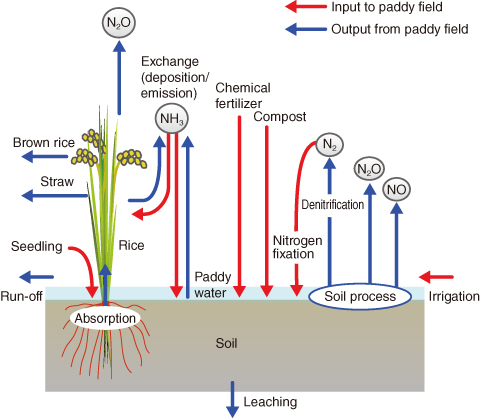
Fig.4-21 Nitrogen cycling at rice paddy

Fig.4-22 SOLVEG simulation of NH3 exchange over rice paddy (a) during fallow period and (b) cropping period
To develop the model for various environmental material-transport studies, we applied the SOLVEG (Multi-layer Atmosphere-SOiL-VEGetation Model) to those studies, which is the land surface model for prediction of radioactive materials transfer between atmosphere and land surface. In the present study and in cooperation with National Institute for Agro-Environmental Sciences, Japan, we newly modeled ammonia (NH3) exchange process above rice paddy fields.
Rice paddies are not only the major arable ecosystems providing the staple food in Asia, but also substantial sources of greenhouse gases such as nitrous oxide (N2O). The emission of greenhouse depends on complicated processes of nitrogen cycling between the atmosphere, rice paddies and soil (Fig.4-21). NH3 in the atmosphere above paddy fields is absorbed by the stomata of rice foliage and/or is dissolved by paddy water (NH3 deposition). However, NH3 is often emitted from the paddy when nitrogen fertilizer is provided (NH3 emission). The accurate estimate of this bidirectional NH3 exchange (the difference between NH3 emission and deposition) is not straightforward and remains a key issue in the prediction of the greenhouse gas emission from rice paddies.
Hence, we developed new modules for SOLVEG to predict the paddy water temperature and the NH3 concentrations in the foliage and at the surface of paddy water or soil. The modified SOLVEG model reproduced the observed NH3 exchange rate at the Mase rice paddy site in Ibaraki, Japan (Fig.4-22). We also investigated how amount of NH3 is exchanged during rice growth. The result revealed that the recapture by the foliage of NH3 from the surface of the paddy water (NH3 recapture) tends to increase with rice growth. Once maturity is reached, most volatilized NH3 is recaptured in rice canopies and no longer transfers to the atmosphere. By allowing the reduction of the vaporization loss of NH3 to the atmosphere, this result is useful for managing supplemental fertilization of rice paddies.
The present study was partly supported by Japan Society for the Promotion of Science (JSPS) KAKENHI Grant-in-Aid for Scientific Research (A) (No.22248026).